Analysis of Nestle's Business Environment and Organizational Structure
VerifiedAdded on 2020/06/03
|15
|3628
|341
Report
AI Summary
This report provides a comprehensive analysis of Nestle's business environment, encompassing its organizational structure, functions, and the impact of various macro-environmental factors. The report begins with an introduction to the business environment, differentiating between internal and external factors influencing organizational operations. It then delves into the types and purposes of organizations, focusing on Nestle as a private sector entity. The analysis covers the relationship between different organizational functions like human resources, marketing, finance, and production, and how they are interlinked with organizational objectives and structure. Furthermore, the report examines Nestle's matrix organizational structure, detailing its advantages. A significant portion of the report is dedicated to identifying the positive and negative impacts of the macro environment on Nestle's business operations, utilizing PESTLE analysis to evaluate political, economic, social, technological, environmental, and legal factors. Finally, the report concludes by summarizing the key findings and insights gained from the analysis.
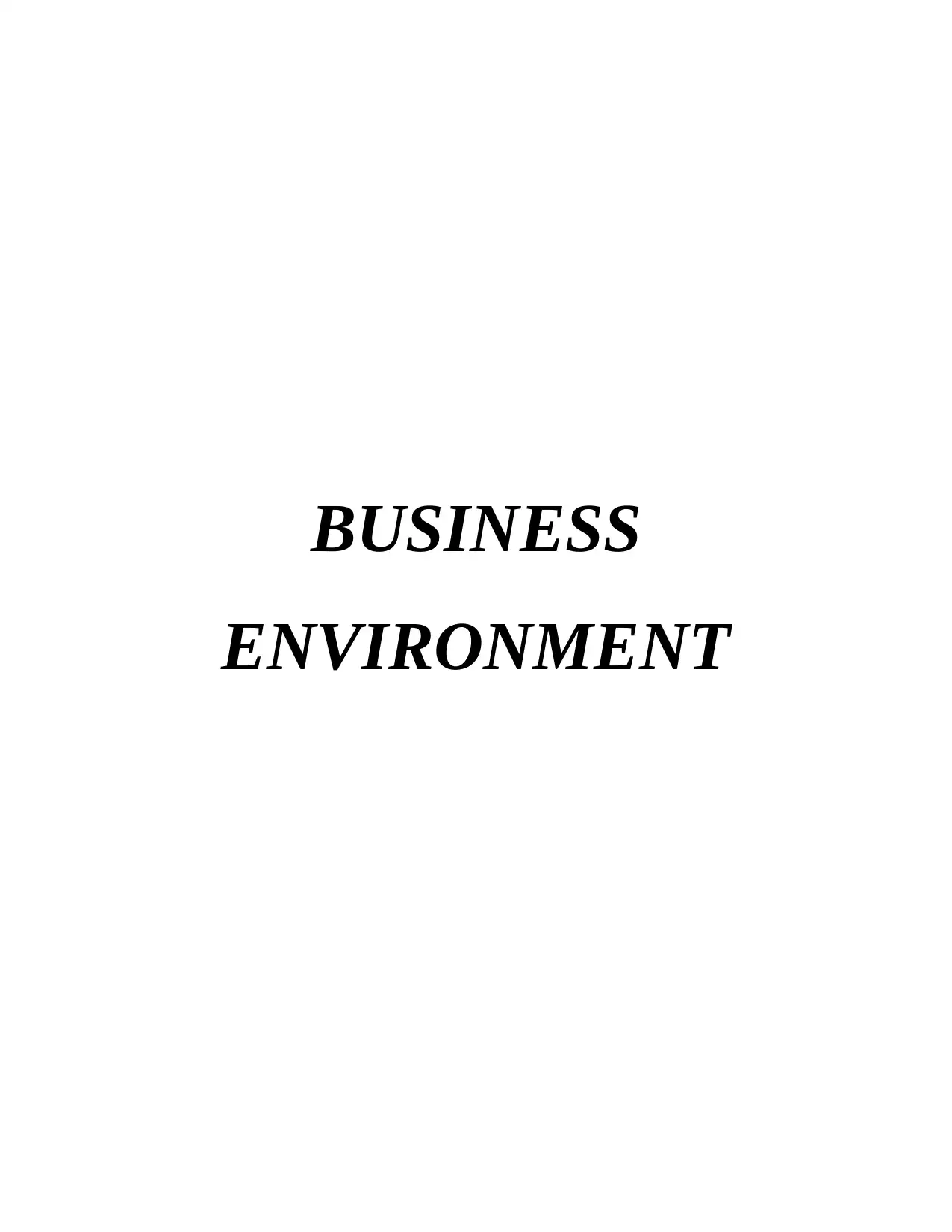
BUSINESS
ENVIRONMENT
ENVIRONMENT
Paraphrase This Document
Need a fresh take? Get an instant paraphrase of this document with our AI Paraphraser
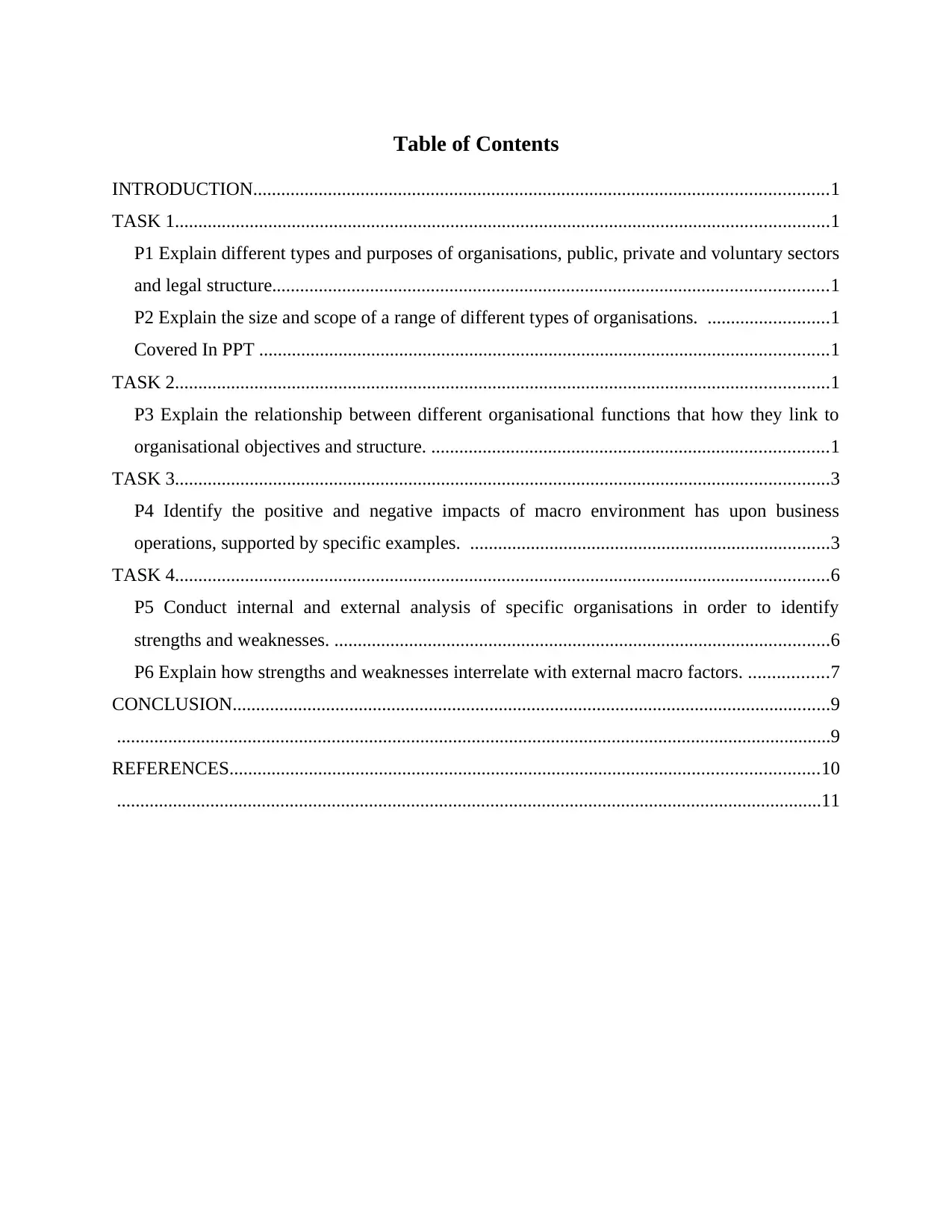
Table of Contents
INTRODUCTION...........................................................................................................................1
TASK 1............................................................................................................................................1
P1 Explain different types and purposes of organisations, public, private and voluntary sectors
and legal structure.......................................................................................................................1
P2 Explain the size and scope of a range of different types of organisations. ..........................1
Covered In PPT ..........................................................................................................................1
TASK 2............................................................................................................................................1
P3 Explain the relationship between different organisational functions that how they link to
organisational objectives and structure. .....................................................................................1
TASK 3............................................................................................................................................3
P4 Identify the positive and negative impacts of macro environment has upon business
operations, supported by specific examples. .............................................................................3
TASK 4............................................................................................................................................6
P5 Conduct internal and external analysis of specific organisations in order to identify
strengths and weaknesses. ..........................................................................................................6
P6 Explain how strengths and weaknesses interrelate with external macro factors. .................7
CONCLUSION................................................................................................................................9
.........................................................................................................................................................9
REFERENCES..............................................................................................................................10
.......................................................................................................................................................11
INTRODUCTION...........................................................................................................................1
TASK 1............................................................................................................................................1
P1 Explain different types and purposes of organisations, public, private and voluntary sectors
and legal structure.......................................................................................................................1
P2 Explain the size and scope of a range of different types of organisations. ..........................1
Covered In PPT ..........................................................................................................................1
TASK 2............................................................................................................................................1
P3 Explain the relationship between different organisational functions that how they link to
organisational objectives and structure. .....................................................................................1
TASK 3............................................................................................................................................3
P4 Identify the positive and negative impacts of macro environment has upon business
operations, supported by specific examples. .............................................................................3
TASK 4............................................................................................................................................6
P5 Conduct internal and external analysis of specific organisations in order to identify
strengths and weaknesses. ..........................................................................................................6
P6 Explain how strengths and weaknesses interrelate with external macro factors. .................7
CONCLUSION................................................................................................................................9
.........................................................................................................................................................9
REFERENCES..............................................................................................................................10
.......................................................................................................................................................11
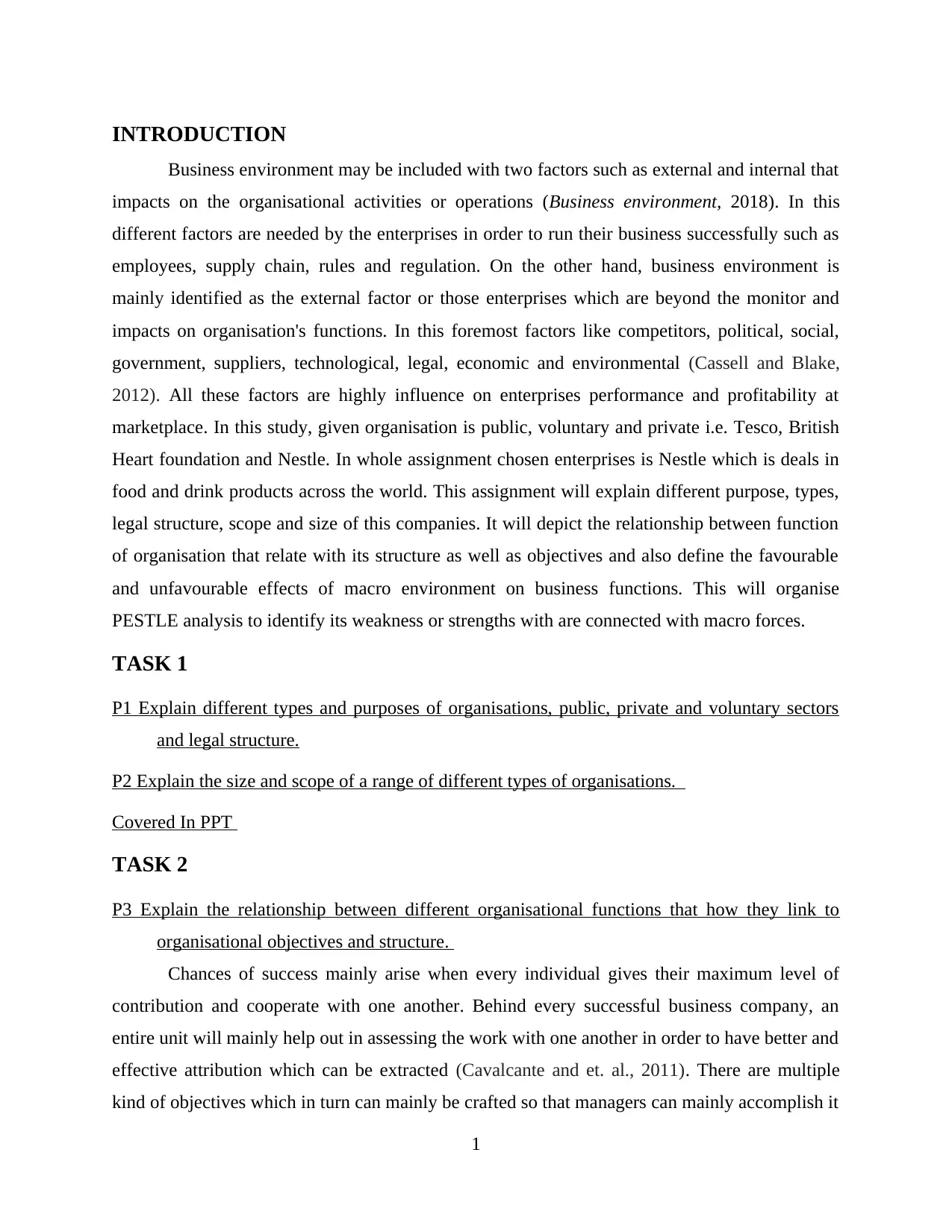
INTRODUCTION
Business environment may be included with two factors such as external and internal that
impacts on the organisational activities or operations (Business environment, 2018). In this
different factors are needed by the enterprises in order to run their business successfully such as
employees, supply chain, rules and regulation. On the other hand, business environment is
mainly identified as the external factor or those enterprises which are beyond the monitor and
impacts on organisation's functions. In this foremost factors like competitors, political, social,
government, suppliers, technological, legal, economic and environmental (Cassell and Blake,
2012). All these factors are highly influence on enterprises performance and profitability at
marketplace. In this study, given organisation is public, voluntary and private i.e. Tesco, British
Heart foundation and Nestle. In whole assignment chosen enterprises is Nestle which is deals in
food and drink products across the world. This assignment will explain different purpose, types,
legal structure, scope and size of this companies. It will depict the relationship between function
of organisation that relate with its structure as well as objectives and also define the favourable
and unfavourable effects of macro environment on business functions. This will organise
PESTLE analysis to identify its weakness or strengths with are connected with macro forces.
TASK 1
P1 Explain different types and purposes of organisations, public, private and voluntary sectors
and legal structure.
P2 Explain the size and scope of a range of different types of organisations.
Covered In PPT
TASK 2
P3 Explain the relationship between different organisational functions that how they link to
organisational objectives and structure.
Chances of success mainly arise when every individual gives their maximum level of
contribution and cooperate with one another. Behind every successful business company, an
entire unit will mainly help out in assessing the work with one another in order to have better and
effective attribution which can be extracted (Cavalcante and et. al., 2011). There are multiple
kind of objectives which in turn can mainly be crafted so that managers can mainly accomplish it
1
Business environment may be included with two factors such as external and internal that
impacts on the organisational activities or operations (Business environment, 2018). In this
different factors are needed by the enterprises in order to run their business successfully such as
employees, supply chain, rules and regulation. On the other hand, business environment is
mainly identified as the external factor or those enterprises which are beyond the monitor and
impacts on organisation's functions. In this foremost factors like competitors, political, social,
government, suppliers, technological, legal, economic and environmental (Cassell and Blake,
2012). All these factors are highly influence on enterprises performance and profitability at
marketplace. In this study, given organisation is public, voluntary and private i.e. Tesco, British
Heart foundation and Nestle. In whole assignment chosen enterprises is Nestle which is deals in
food and drink products across the world. This assignment will explain different purpose, types,
legal structure, scope and size of this companies. It will depict the relationship between function
of organisation that relate with its structure as well as objectives and also define the favourable
and unfavourable effects of macro environment on business functions. This will organise
PESTLE analysis to identify its weakness or strengths with are connected with macro forces.
TASK 1
P1 Explain different types and purposes of organisations, public, private and voluntary sectors
and legal structure.
P2 Explain the size and scope of a range of different types of organisations.
Covered In PPT
TASK 2
P3 Explain the relationship between different organisational functions that how they link to
organisational objectives and structure.
Chances of success mainly arise when every individual gives their maximum level of
contribution and cooperate with one another. Behind every successful business company, an
entire unit will mainly help out in assessing the work with one another in order to have better and
effective attribution which can be extracted (Cavalcante and et. al., 2011). There are multiple
kind of objectives which in turn can mainly be crafted so that managers can mainly accomplish it
1
⊘ This is a preview!⊘
Do you want full access?
Subscribe today to unlock all pages.

Trusted by 1+ million students worldwide
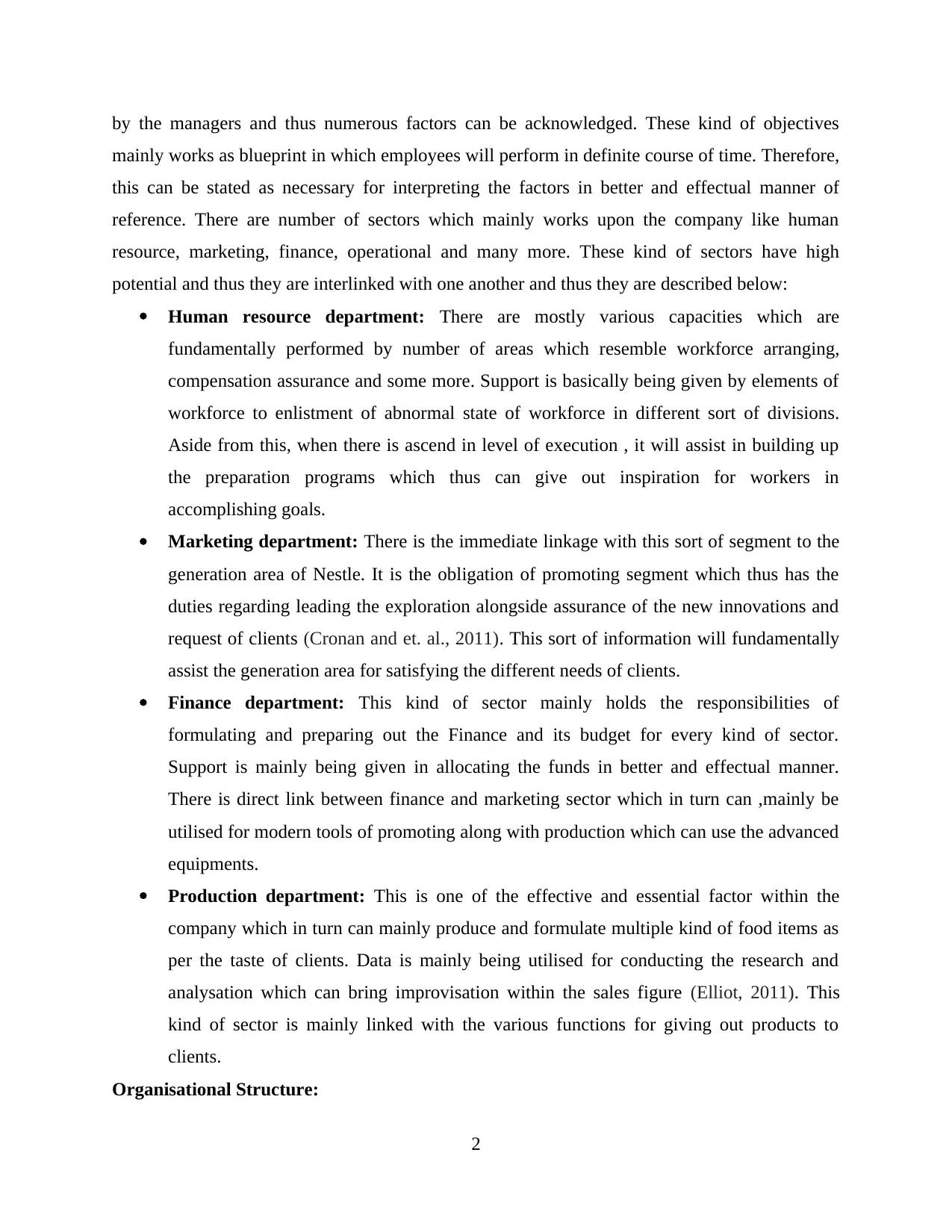
by the managers and thus numerous factors can be acknowledged. These kind of objectives
mainly works as blueprint in which employees will perform in definite course of time. Therefore,
this can be stated as necessary for interpreting the factors in better and effectual manner of
reference. There are number of sectors which mainly works upon the company like human
resource, marketing, finance, operational and many more. These kind of sectors have high
potential and thus they are interlinked with one another and thus they are described below:
Human resource department: There are mostly various capacities which are
fundamentally performed by number of areas which resemble workforce arranging,
compensation assurance and some more. Support is basically being given by elements of
workforce to enlistment of abnormal state of workforce in different sort of divisions.
Aside from this, when there is ascend in level of execution , it will assist in building up
the preparation programs which thus can give out inspiration for workers in
accomplishing goals.
Marketing department: There is the immediate linkage with this sort of segment to the
generation area of Nestle. It is the obligation of promoting segment which thus has the
duties regarding leading the exploration alongside assurance of the new innovations and
request of clients (Cronan and et. al., 2011). This sort of information will fundamentally
assist the generation area for satisfying the different needs of clients.
Finance department: This kind of sector mainly holds the responsibilities of
formulating and preparing out the Finance and its budget for every kind of sector.
Support is mainly being given in allocating the funds in better and effectual manner.
There is direct link between finance and marketing sector which in turn can ,mainly be
utilised for modern tools of promoting along with production which can use the advanced
equipments.
Production department: This is one of the effective and essential factor within the
company which in turn can mainly produce and formulate multiple kind of food items as
per the taste of clients. Data is mainly being utilised for conducting the research and
analysation which can bring improvisation within the sales figure (Elliot, 2011). This
kind of sector is mainly linked with the various functions for giving out products to
clients.
Organisational Structure:
2
mainly works as blueprint in which employees will perform in definite course of time. Therefore,
this can be stated as necessary for interpreting the factors in better and effectual manner of
reference. There are number of sectors which mainly works upon the company like human
resource, marketing, finance, operational and many more. These kind of sectors have high
potential and thus they are interlinked with one another and thus they are described below:
Human resource department: There are mostly various capacities which are
fundamentally performed by number of areas which resemble workforce arranging,
compensation assurance and some more. Support is basically being given by elements of
workforce to enlistment of abnormal state of workforce in different sort of divisions.
Aside from this, when there is ascend in level of execution , it will assist in building up
the preparation programs which thus can give out inspiration for workers in
accomplishing goals.
Marketing department: There is the immediate linkage with this sort of segment to the
generation area of Nestle. It is the obligation of promoting segment which thus has the
duties regarding leading the exploration alongside assurance of the new innovations and
request of clients (Cronan and et. al., 2011). This sort of information will fundamentally
assist the generation area for satisfying the different needs of clients.
Finance department: This kind of sector mainly holds the responsibilities of
formulating and preparing out the Finance and its budget for every kind of sector.
Support is mainly being given in allocating the funds in better and effectual manner.
There is direct link between finance and marketing sector which in turn can ,mainly be
utilised for modern tools of promoting along with production which can use the advanced
equipments.
Production department: This is one of the effective and essential factor within the
company which in turn can mainly produce and formulate multiple kind of food items as
per the taste of clients. Data is mainly being utilised for conducting the research and
analysation which can bring improvisation within the sales figure (Elliot, 2011). This
kind of sector is mainly linked with the various functions for giving out products to
clients.
Organisational Structure:
2
Paraphrase This Document
Need a fresh take? Get an instant paraphrase of this document with our AI Paraphraser
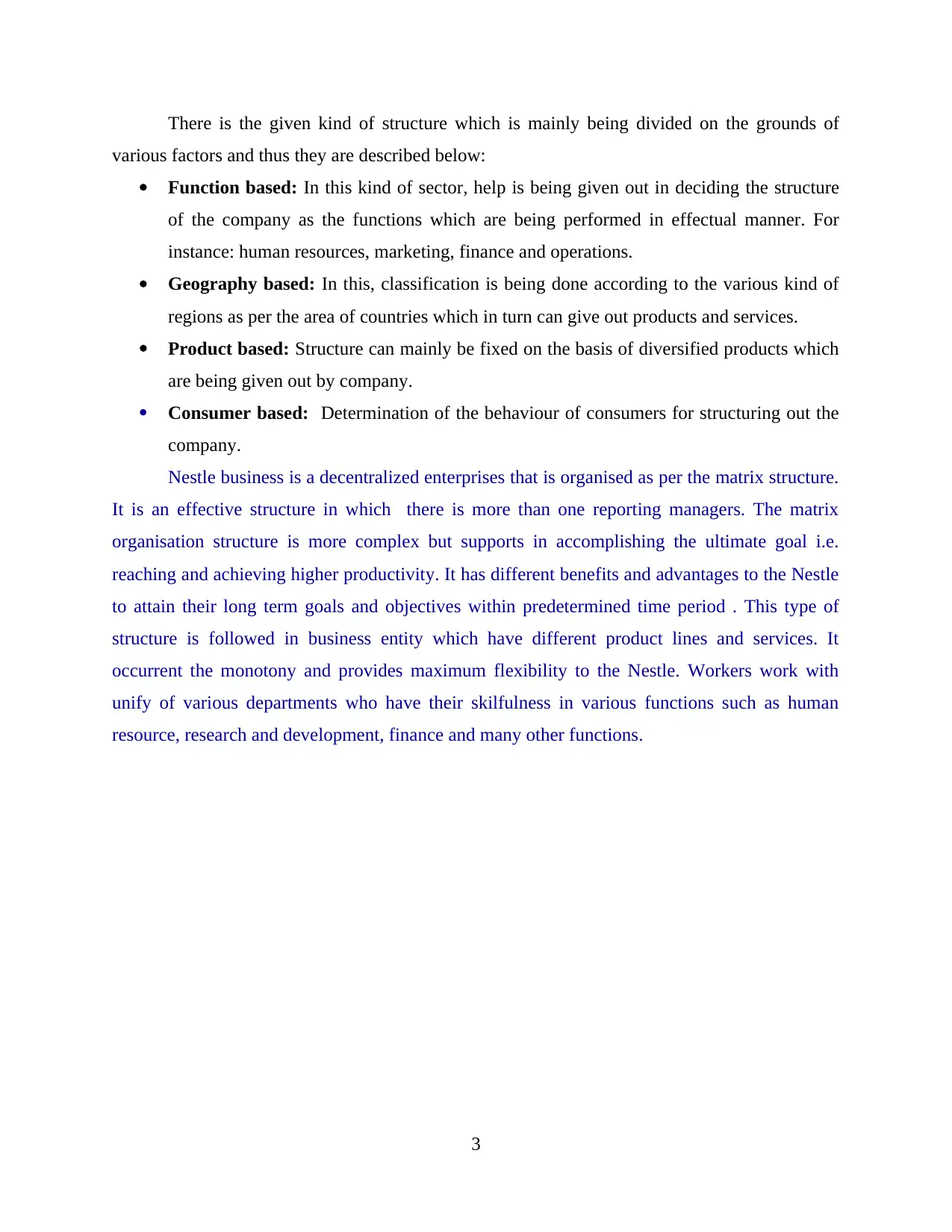
There is the given kind of structure which is mainly being divided on the grounds of
various factors and thus they are described below:
Function based: In this kind of sector, help is being given out in deciding the structure
of the company as the functions which are being performed in effectual manner. For
instance: human resources, marketing, finance and operations.
Geography based: In this, classification is being done according to the various kind of
regions as per the area of countries which in turn can give out products and services.
Product based: Structure can mainly be fixed on the basis of diversified products which
are being given out by company.
Consumer based: Determination of the behaviour of consumers for structuring out the
company.
Nestle business is a decentralized enterprises that is organised as per the matrix structure.
It is an effective structure in which there is more than one reporting managers. The matrix
organisation structure is more complex but supports in accomplishing the ultimate goal i.e.
reaching and achieving higher productivity. It has different benefits and advantages to the Nestle
to attain their long term goals and objectives within predetermined time period . This type of
structure is followed in business entity which have different product lines and services. It
occurrent the monotony and provides maximum flexibility to the Nestle. Workers work with
unify of various departments who have their skilfulness in various functions such as human
resource, research and development, finance and many other functions.
3
various factors and thus they are described below:
Function based: In this kind of sector, help is being given out in deciding the structure
of the company as the functions which are being performed in effectual manner. For
instance: human resources, marketing, finance and operations.
Geography based: In this, classification is being done according to the various kind of
regions as per the area of countries which in turn can give out products and services.
Product based: Structure can mainly be fixed on the basis of diversified products which
are being given out by company.
Consumer based: Determination of the behaviour of consumers for structuring out the
company.
Nestle business is a decentralized enterprises that is organised as per the matrix structure.
It is an effective structure in which there is more than one reporting managers. The matrix
organisation structure is more complex but supports in accomplishing the ultimate goal i.e.
reaching and achieving higher productivity. It has different benefits and advantages to the Nestle
to attain their long term goals and objectives within predetermined time period . This type of
structure is followed in business entity which have different product lines and services. It
occurrent the monotony and provides maximum flexibility to the Nestle. Workers work with
unify of various departments who have their skilfulness in various functions such as human
resource, research and development, finance and many other functions.
3
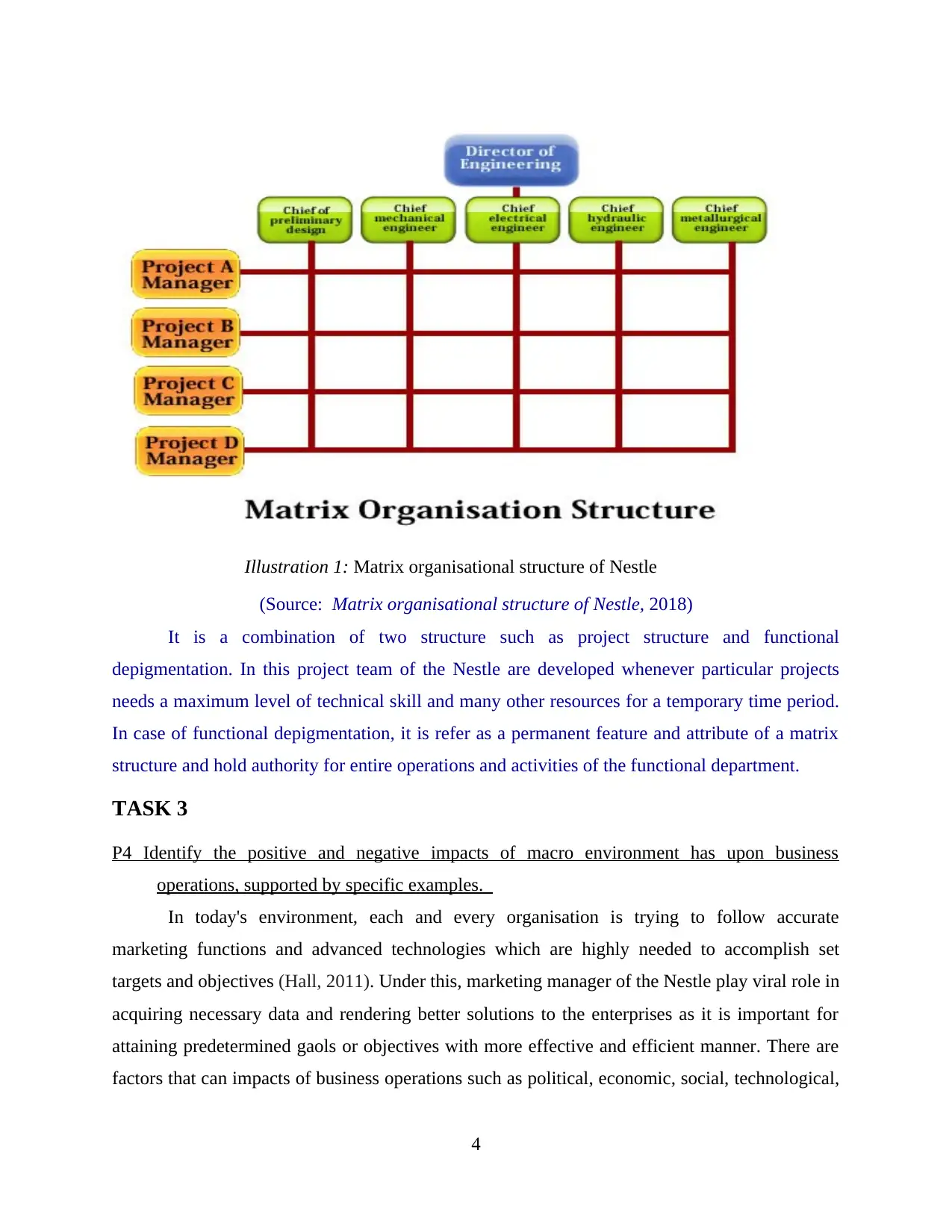
Illustration 1: Matrix organisational structure of Nestle
(Source: Matrix organisational structure of Nestle, 2018)
It is a combination of two structure such as project structure and functional
depigmentation. In this project team of the Nestle are developed whenever particular projects
needs a maximum level of technical skill and many other resources for a temporary time period.
In case of functional depigmentation, it is refer as a permanent feature and attribute of a matrix
structure and hold authority for entire operations and activities of the functional department.
TASK 3
P4 Identify the positive and negative impacts of macro environment has upon business
operations, supported by specific examples.
In today's environment, each and every organisation is trying to follow accurate
marketing functions and advanced technologies which are highly needed to accomplish set
targets and objectives (Hall, 2011). Under this, marketing manager of the Nestle play viral role in
acquiring necessary data and rendering better solutions to the enterprises as it is important for
attaining predetermined gaols or objectives with more effective and efficient manner. There are
factors that can impacts of business operations such as political, economic, social, technological,
4
(Source: Matrix organisational structure of Nestle, 2018)
It is a combination of two structure such as project structure and functional
depigmentation. In this project team of the Nestle are developed whenever particular projects
needs a maximum level of technical skill and many other resources for a temporary time period.
In case of functional depigmentation, it is refer as a permanent feature and attribute of a matrix
structure and hold authority for entire operations and activities of the functional department.
TASK 3
P4 Identify the positive and negative impacts of macro environment has upon business
operations, supported by specific examples.
In today's environment, each and every organisation is trying to follow accurate
marketing functions and advanced technologies which are highly needed to accomplish set
targets and objectives (Hall, 2011). Under this, marketing manager of the Nestle play viral role in
acquiring necessary data and rendering better solutions to the enterprises as it is important for
attaining predetermined gaols or objectives with more effective and efficient manner. There are
factors that can impacts of business operations such as political, economic, social, technological,
4
⊘ This is a preview!⊘
Do you want full access?
Subscribe today to unlock all pages.

Trusted by 1+ million students worldwide
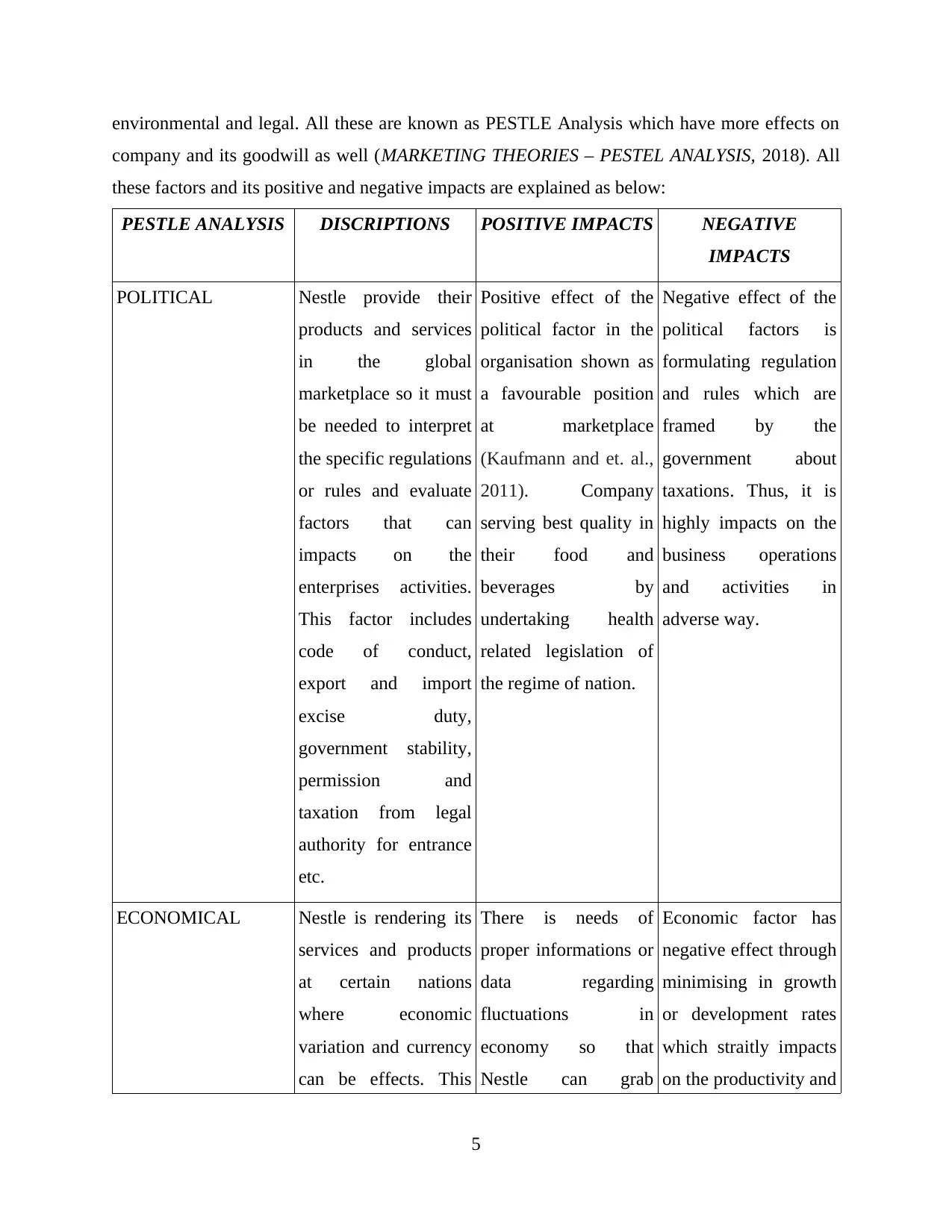
environmental and legal. All these are known as PESTLE Analysis which have more effects on
company and its goodwill as well (MARKETING THEORIES – PESTEL ANALYSIS, 2018). All
these factors and its positive and negative impacts are explained as below:
PESTLE ANALYSIS DISCRIPTIONS POSITIVE IMPACTS NEGATIVE
IMPACTS
POLITICAL Nestle provide their
products and services
in the global
marketplace so it must
be needed to interpret
the specific regulations
or rules and evaluate
factors that can
impacts on the
enterprises activities.
This factor includes
code of conduct,
export and import
excise duty,
government stability,
permission and
taxation from legal
authority for entrance
etc.
Positive effect of the
political factor in the
organisation shown as
a favourable position
at marketplace
(Kaufmann and et. al.,
2011). Company
serving best quality in
their food and
beverages by
undertaking health
related legislation of
the regime of nation.
Negative effect of the
political factors is
formulating regulation
and rules which are
framed by the
government about
taxations. Thus, it is
highly impacts on the
business operations
and activities in
adverse way.
ECONOMICAL Nestle is rendering its
services and products
at certain nations
where economic
variation and currency
can be effects. This
There is needs of
proper informations or
data regarding
fluctuations in
economy so that
Nestle can grab
Economic factor has
negative effect through
minimising in growth
or development rates
which straitly impacts
on the productivity and
5
company and its goodwill as well (MARKETING THEORIES – PESTEL ANALYSIS, 2018). All
these factors and its positive and negative impacts are explained as below:
PESTLE ANALYSIS DISCRIPTIONS POSITIVE IMPACTS NEGATIVE
IMPACTS
POLITICAL Nestle provide their
products and services
in the global
marketplace so it must
be needed to interpret
the specific regulations
or rules and evaluate
factors that can
impacts on the
enterprises activities.
This factor includes
code of conduct,
export and import
excise duty,
government stability,
permission and
taxation from legal
authority for entrance
etc.
Positive effect of the
political factor in the
organisation shown as
a favourable position
at marketplace
(Kaufmann and et. al.,
2011). Company
serving best quality in
their food and
beverages by
undertaking health
related legislation of
the regime of nation.
Negative effect of the
political factors is
formulating regulation
and rules which are
framed by the
government about
taxations. Thus, it is
highly impacts on the
business operations
and activities in
adverse way.
ECONOMICAL Nestle is rendering its
services and products
at certain nations
where economic
variation and currency
can be effects. This
There is needs of
proper informations or
data regarding
fluctuations in
economy so that
Nestle can grab
Economic factor has
negative effect through
minimising in growth
or development rates
which straitly impacts
on the productivity and
5
Paraphrase This Document
Need a fresh take? Get an instant paraphrase of this document with our AI Paraphraser
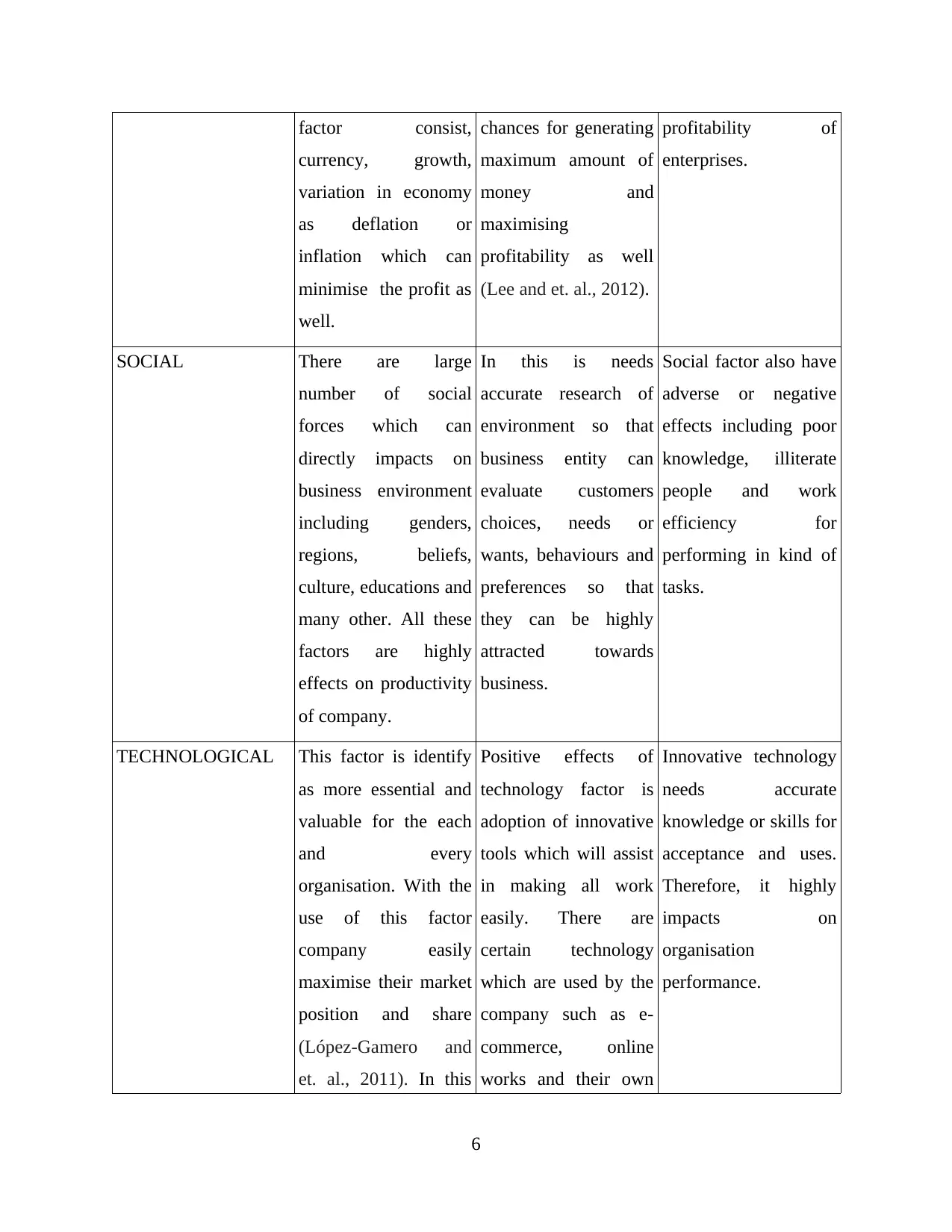
factor consist,
currency, growth,
variation in economy
as deflation or
inflation which can
minimise the profit as
well.
chances for generating
maximum amount of
money and
maximising
profitability as well
(Lee and et. al., 2012).
profitability of
enterprises.
SOCIAL There are large
number of social
forces which can
directly impacts on
business environment
including genders,
regions, beliefs,
culture, educations and
many other. All these
factors are highly
effects on productivity
of company.
In this is needs
accurate research of
environment so that
business entity can
evaluate customers
choices, needs or
wants, behaviours and
preferences so that
they can be highly
attracted towards
business.
Social factor also have
adverse or negative
effects including poor
knowledge, illiterate
people and work
efficiency for
performing in kind of
tasks.
TECHNOLOGICAL This factor is identify
as more essential and
valuable for the each
and every
organisation. With the
use of this factor
company easily
maximise their market
position and share
(López-Gamero and
et. al., 2011). In this
Positive effects of
technology factor is
adoption of innovative
tools which will assist
in making all work
easily. There are
certain technology
which are used by the
company such as e-
commerce, online
works and their own
Innovative technology
needs accurate
knowledge or skills for
acceptance and uses.
Therefore, it highly
impacts on
organisation
performance.
6
currency, growth,
variation in economy
as deflation or
inflation which can
minimise the profit as
well.
chances for generating
maximum amount of
money and
maximising
profitability as well
(Lee and et. al., 2012).
profitability of
enterprises.
SOCIAL There are large
number of social
forces which can
directly impacts on
business environment
including genders,
regions, beliefs,
culture, educations and
many other. All these
factors are highly
effects on productivity
of company.
In this is needs
accurate research of
environment so that
business entity can
evaluate customers
choices, needs or
wants, behaviours and
preferences so that
they can be highly
attracted towards
business.
Social factor also have
adverse or negative
effects including poor
knowledge, illiterate
people and work
efficiency for
performing in kind of
tasks.
TECHNOLOGICAL This factor is identify
as more essential and
valuable for the each
and every
organisation. With the
use of this factor
company easily
maximise their market
position and share
(López-Gamero and
et. al., 2011). In this
Positive effects of
technology factor is
adoption of innovative
tools which will assist
in making all work
easily. There are
certain technology
which are used by the
company such as e-
commerce, online
works and their own
Innovative technology
needs accurate
knowledge or skills for
acceptance and uses.
Therefore, it highly
impacts on
organisation
performance.
6
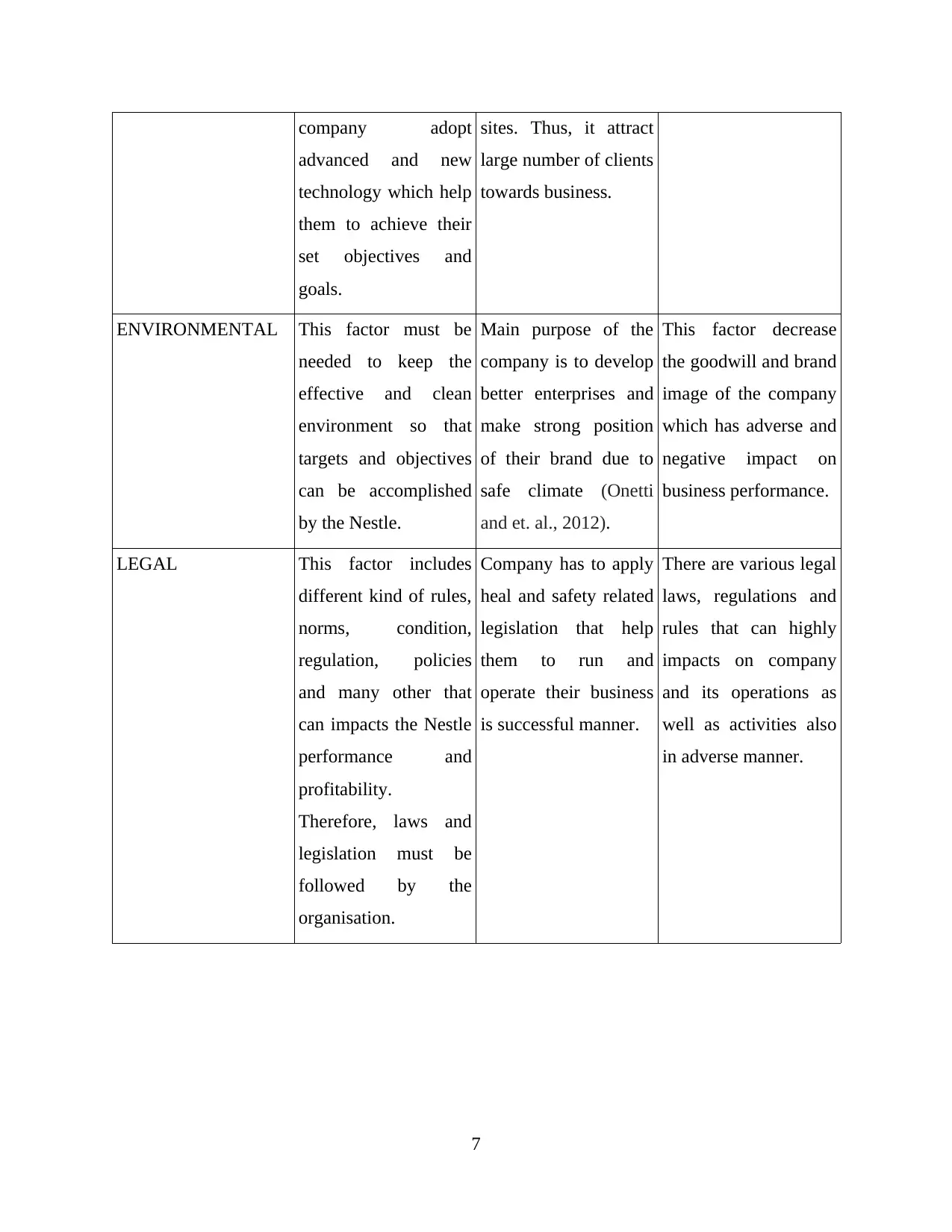
company adopt
advanced and new
technology which help
them to achieve their
set objectives and
goals.
sites. Thus, it attract
large number of clients
towards business.
ENVIRONMENTAL This factor must be
needed to keep the
effective and clean
environment so that
targets and objectives
can be accomplished
by the Nestle.
Main purpose of the
company is to develop
better enterprises and
make strong position
of their brand due to
safe climate (Onetti
and et. al., 2012).
This factor decrease
the goodwill and brand
image of the company
which has adverse and
negative impact on
business performance.
LEGAL This factor includes
different kind of rules,
norms, condition,
regulation, policies
and many other that
can impacts the Nestle
performance and
profitability.
Therefore, laws and
legislation must be
followed by the
organisation.
Company has to apply
heal and safety related
legislation that help
them to run and
operate their business
is successful manner.
There are various legal
laws, regulations and
rules that can highly
impacts on company
and its operations as
well as activities also
in adverse manner.
7
advanced and new
technology which help
them to achieve their
set objectives and
goals.
sites. Thus, it attract
large number of clients
towards business.
ENVIRONMENTAL This factor must be
needed to keep the
effective and clean
environment so that
targets and objectives
can be accomplished
by the Nestle.
Main purpose of the
company is to develop
better enterprises and
make strong position
of their brand due to
safe climate (Onetti
and et. al., 2012).
This factor decrease
the goodwill and brand
image of the company
which has adverse and
negative impact on
business performance.
LEGAL This factor includes
different kind of rules,
norms, condition,
regulation, policies
and many other that
can impacts the Nestle
performance and
profitability.
Therefore, laws and
legislation must be
followed by the
organisation.
Company has to apply
heal and safety related
legislation that help
them to run and
operate their business
is successful manner.
There are various legal
laws, regulations and
rules that can highly
impacts on company
and its operations as
well as activities also
in adverse manner.
7
⊘ This is a preview!⊘
Do you want full access?
Subscribe today to unlock all pages.

Trusted by 1+ million students worldwide
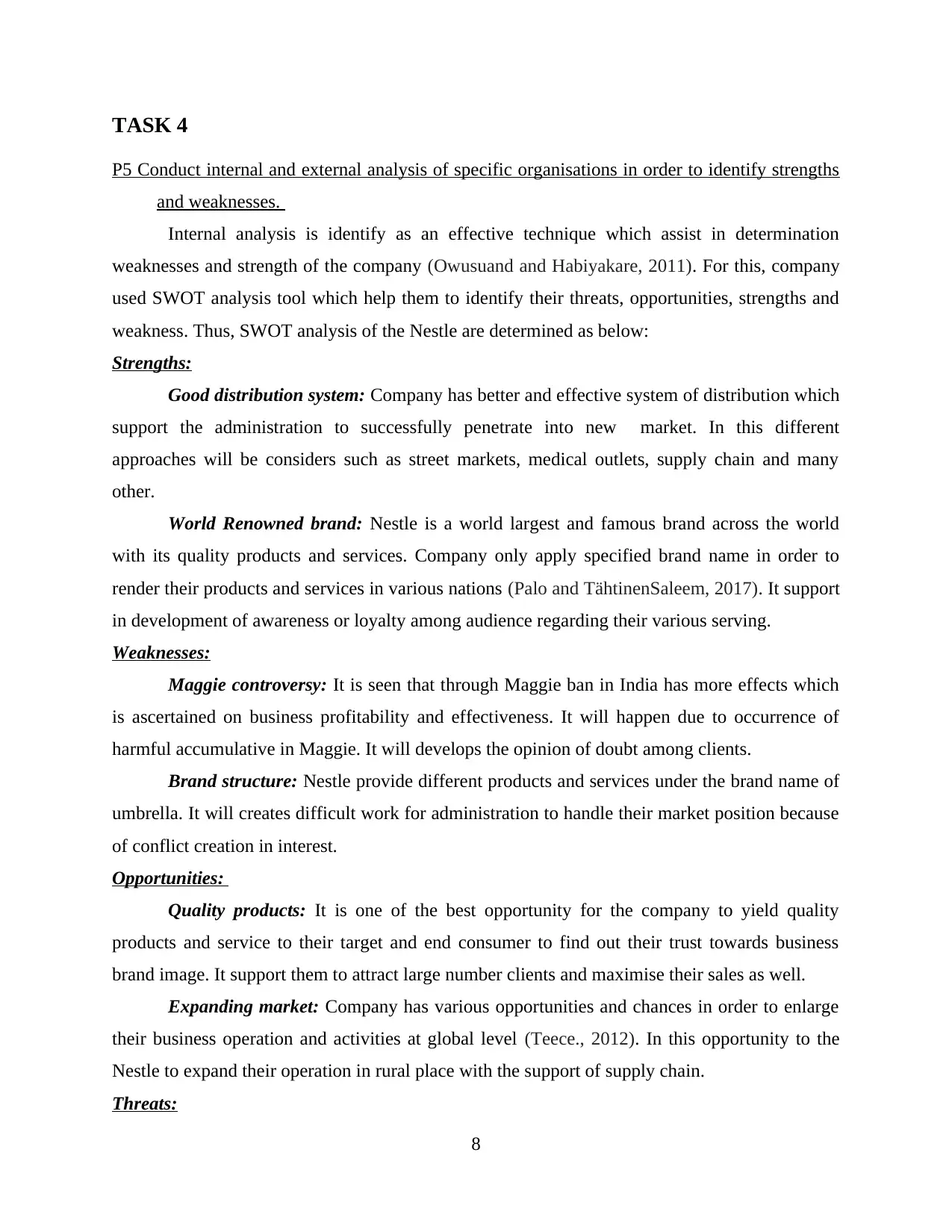
TASK 4
P5 Conduct internal and external analysis of specific organisations in order to identify strengths
and weaknesses.
Internal analysis is identify as an effective technique which assist in determination
weaknesses and strength of the company (Owusuand and Habiyakare, 2011). For this, company
used SWOT analysis tool which help them to identify their threats, opportunities, strengths and
weakness. Thus, SWOT analysis of the Nestle are determined as below:
Strengths:
Good distribution system: Company has better and effective system of distribution which
support the administration to successfully penetrate into new market. In this different
approaches will be considers such as street markets, medical outlets, supply chain and many
other.
World Renowned brand: Nestle is a world largest and famous brand across the world
with its quality products and services. Company only apply specified brand name in order to
render their products and services in various nations (Palo and TähtinenSaleem, 2017). It support
in development of awareness or loyalty among audience regarding their various serving.
Weaknesses:
Maggie controversy: It is seen that through Maggie ban in India has more effects which
is ascertained on business profitability and effectiveness. It will happen due to occurrence of
harmful accumulative in Maggie. It will develops the opinion of doubt among clients.
Brand structure: Nestle provide different products and services under the brand name of
umbrella. It will creates difficult work for administration to handle their market position because
of conflict creation in interest.
Opportunities:
Quality products: It is one of the best opportunity for the company to yield quality
products and service to their target and end consumer to find out their trust towards business
brand image. It support them to attract large number clients and maximise their sales as well.
Expanding market: Company has various opportunities and chances in order to enlarge
their business operation and activities at global level (Teece., 2012). In this opportunity to the
Nestle to expand their operation in rural place with the support of supply chain.
Threats:
8
P5 Conduct internal and external analysis of specific organisations in order to identify strengths
and weaknesses.
Internal analysis is identify as an effective technique which assist in determination
weaknesses and strength of the company (Owusuand and Habiyakare, 2011). For this, company
used SWOT analysis tool which help them to identify their threats, opportunities, strengths and
weakness. Thus, SWOT analysis of the Nestle are determined as below:
Strengths:
Good distribution system: Company has better and effective system of distribution which
support the administration to successfully penetrate into new market. In this different
approaches will be considers such as street markets, medical outlets, supply chain and many
other.
World Renowned brand: Nestle is a world largest and famous brand across the world
with its quality products and services. Company only apply specified brand name in order to
render their products and services in various nations (Palo and TähtinenSaleem, 2017). It support
in development of awareness or loyalty among audience regarding their various serving.
Weaknesses:
Maggie controversy: It is seen that through Maggie ban in India has more effects which
is ascertained on business profitability and effectiveness. It will happen due to occurrence of
harmful accumulative in Maggie. It will develops the opinion of doubt among clients.
Brand structure: Nestle provide different products and services under the brand name of
umbrella. It will creates difficult work for administration to handle their market position because
of conflict creation in interest.
Opportunities:
Quality products: It is one of the best opportunity for the company to yield quality
products and service to their target and end consumer to find out their trust towards business
brand image. It support them to attract large number clients and maximise their sales as well.
Expanding market: Company has various opportunities and chances in order to enlarge
their business operation and activities at global level (Teece., 2012). In this opportunity to the
Nestle to expand their operation in rural place with the support of supply chain.
Threats:
8
Paraphrase This Document
Need a fresh take? Get an instant paraphrase of this document with our AI Paraphraser
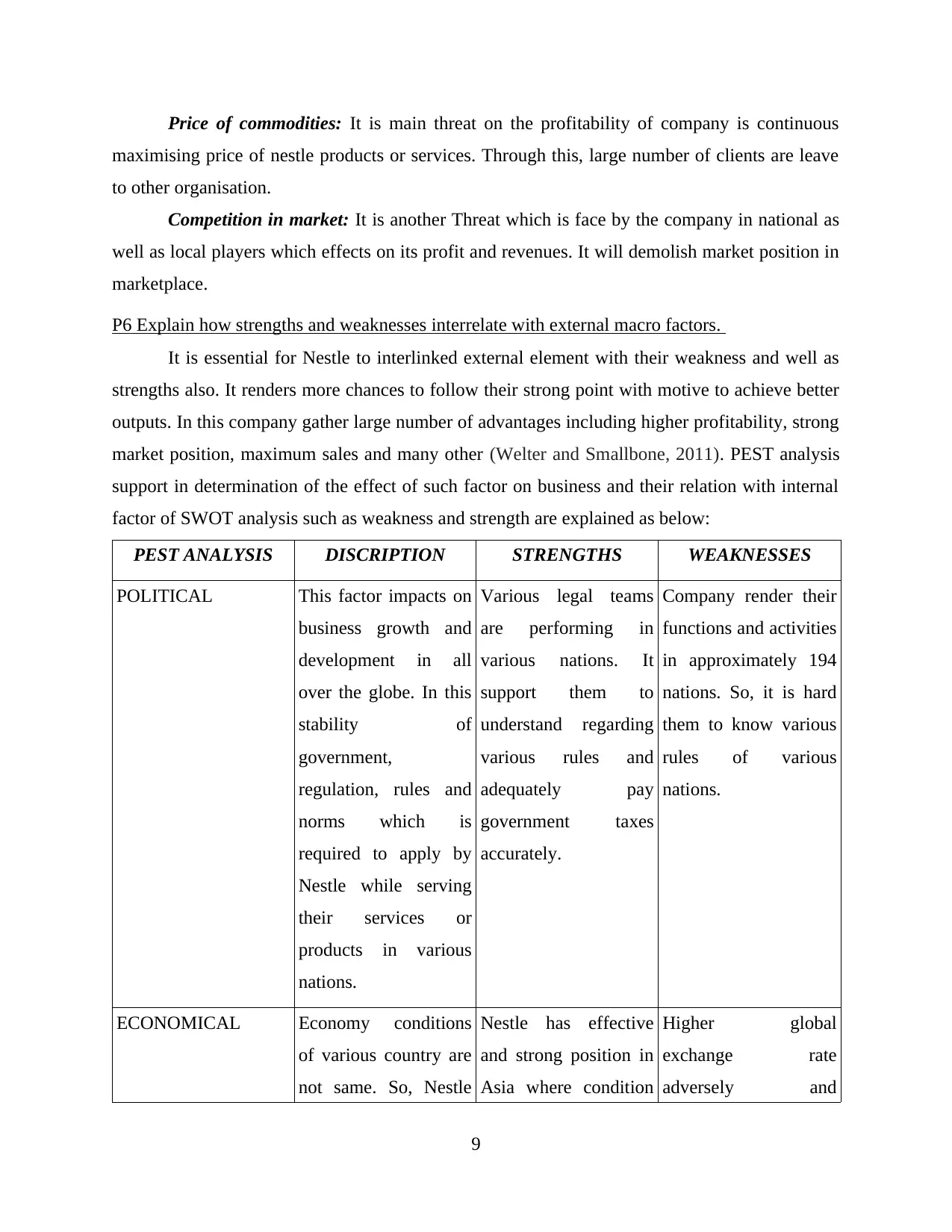
Price of commodities: It is main threat on the profitability of company is continuous
maximising price of nestle products or services. Through this, large number of clients are leave
to other organisation.
Competition in market: It is another Threat which is face by the company in national as
well as local players which effects on its profit and revenues. It will demolish market position in
marketplace.
P6 Explain how strengths and weaknesses interrelate with external macro factors.
It is essential for Nestle to interlinked external element with their weakness and well as
strengths also. It renders more chances to follow their strong point with motive to achieve better
outputs. In this company gather large number of advantages including higher profitability, strong
market position, maximum sales and many other (Welter and Smallbone, 2011). PEST analysis
support in determination of the effect of such factor on business and their relation with internal
factor of SWOT analysis such as weakness and strength are explained as below:
PEST ANALYSIS DISCRIPTION STRENGTHS WEAKNESSES
POLITICAL This factor impacts on
business growth and
development in all
over the globe. In this
stability of
government,
regulation, rules and
norms which is
required to apply by
Nestle while serving
their services or
products in various
nations.
Various legal teams
are performing in
various nations. It
support them to
understand regarding
various rules and
adequately pay
government taxes
accurately.
Company render their
functions and activities
in approximately 194
nations. So, it is hard
them to know various
rules of various
nations.
ECONOMICAL Economy conditions
of various country are
not same. So, Nestle
Nestle has effective
and strong position in
Asia where condition
Higher global
exchange rate
adversely and
9
maximising price of nestle products or services. Through this, large number of clients are leave
to other organisation.
Competition in market: It is another Threat which is face by the company in national as
well as local players which effects on its profit and revenues. It will demolish market position in
marketplace.
P6 Explain how strengths and weaknesses interrelate with external macro factors.
It is essential for Nestle to interlinked external element with their weakness and well as
strengths also. It renders more chances to follow their strong point with motive to achieve better
outputs. In this company gather large number of advantages including higher profitability, strong
market position, maximum sales and many other (Welter and Smallbone, 2011). PEST analysis
support in determination of the effect of such factor on business and their relation with internal
factor of SWOT analysis such as weakness and strength are explained as below:
PEST ANALYSIS DISCRIPTION STRENGTHS WEAKNESSES
POLITICAL This factor impacts on
business growth and
development in all
over the globe. In this
stability of
government,
regulation, rules and
norms which is
required to apply by
Nestle while serving
their services or
products in various
nations.
Various legal teams
are performing in
various nations. It
support them to
understand regarding
various rules and
adequately pay
government taxes
accurately.
Company render their
functions and activities
in approximately 194
nations. So, it is hard
them to know various
rules of various
nations.
ECONOMICAL Economy conditions
of various country are
not same. So, Nestle
Nestle has effective
and strong position in
Asia where condition
Higher global
exchange rate
adversely and
9
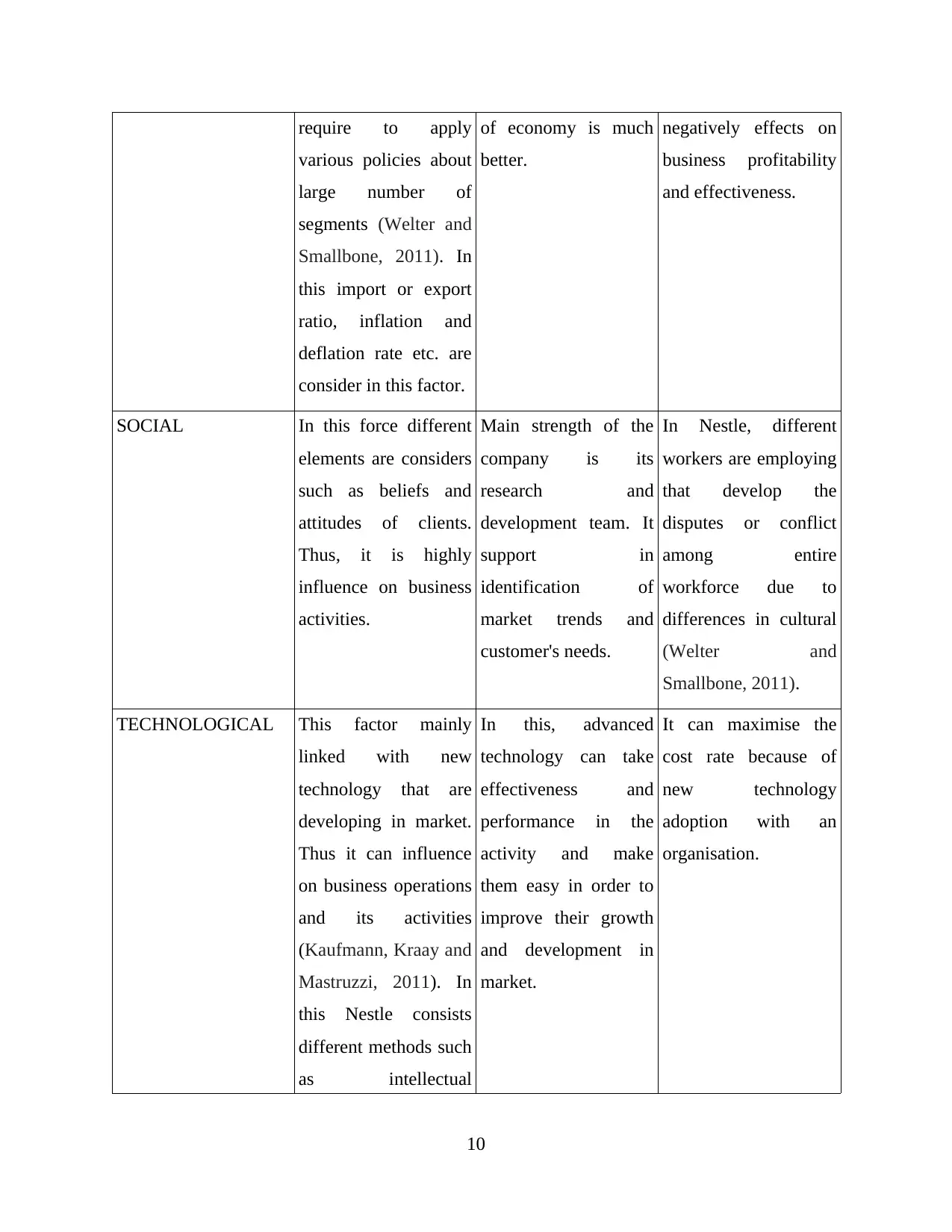
require to apply
various policies about
large number of
segments (Welter and
Smallbone, 2011). In
this import or export
ratio, inflation and
deflation rate etc. are
consider in this factor.
of economy is much
better.
negatively effects on
business profitability
and effectiveness.
SOCIAL In this force different
elements are considers
such as beliefs and
attitudes of clients.
Thus, it is highly
influence on business
activities.
Main strength of the
company is its
research and
development team. It
support in
identification of
market trends and
customer's needs.
In Nestle, different
workers are employing
that develop the
disputes or conflict
among entire
workforce due to
differences in cultural
(Welter and
Smallbone, 2011).
TECHNOLOGICAL This factor mainly
linked with new
technology that are
developing in market.
Thus it can influence
on business operations
and its activities
(Kaufmann, Kraay and
Mastruzzi, 2011). In
this Nestle consists
different methods such
as intellectual
In this, advanced
technology can take
effectiveness and
performance in the
activity and make
them easy in order to
improve their growth
and development in
market.
It can maximise the
cost rate because of
new technology
adoption with an
organisation.
10
various policies about
large number of
segments (Welter and
Smallbone, 2011). In
this import or export
ratio, inflation and
deflation rate etc. are
consider in this factor.
of economy is much
better.
negatively effects on
business profitability
and effectiveness.
SOCIAL In this force different
elements are considers
such as beliefs and
attitudes of clients.
Thus, it is highly
influence on business
activities.
Main strength of the
company is its
research and
development team. It
support in
identification of
market trends and
customer's needs.
In Nestle, different
workers are employing
that develop the
disputes or conflict
among entire
workforce due to
differences in cultural
(Welter and
Smallbone, 2011).
TECHNOLOGICAL This factor mainly
linked with new
technology that are
developing in market.
Thus it can influence
on business operations
and its activities
(Kaufmann, Kraay and
Mastruzzi, 2011). In
this Nestle consists
different methods such
as intellectual
In this, advanced
technology can take
effectiveness and
performance in the
activity and make
them easy in order to
improve their growth
and development in
market.
It can maximise the
cost rate because of
new technology
adoption with an
organisation.
10
⊘ This is a preview!⊘
Do you want full access?
Subscribe today to unlock all pages.

Trusted by 1+ million students worldwide
1 out of 15
Related Documents
Your All-in-One AI-Powered Toolkit for Academic Success.
+13062052269
info@desklib.com
Available 24*7 on WhatsApp / Email
![[object Object]](/_next/static/media/star-bottom.7253800d.svg)
Unlock your academic potential
Copyright © 2020–2025 A2Z Services. All Rights Reserved. Developed and managed by ZUCOL.





